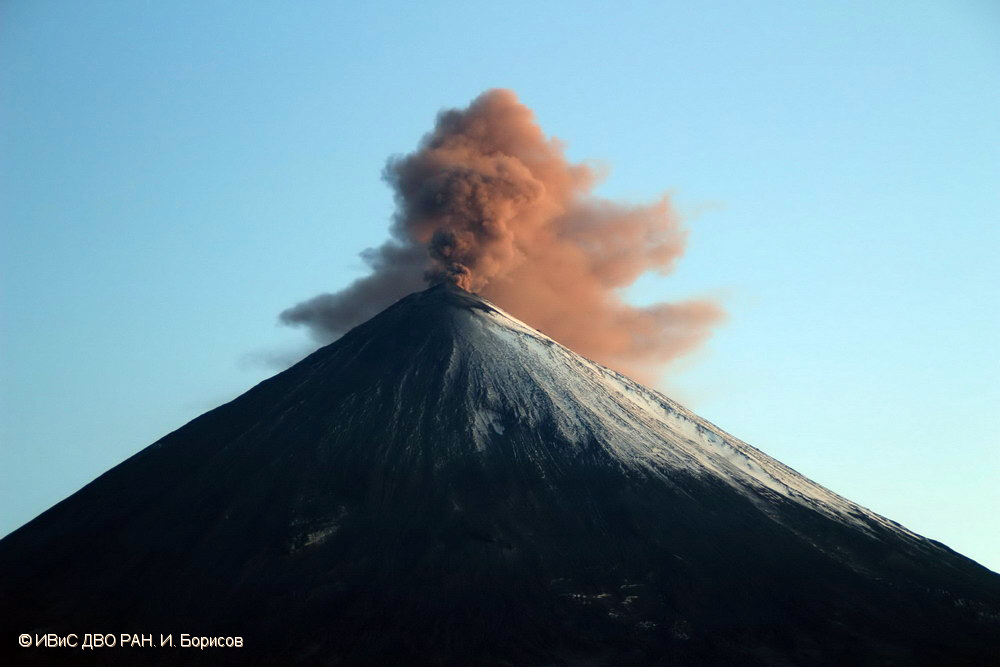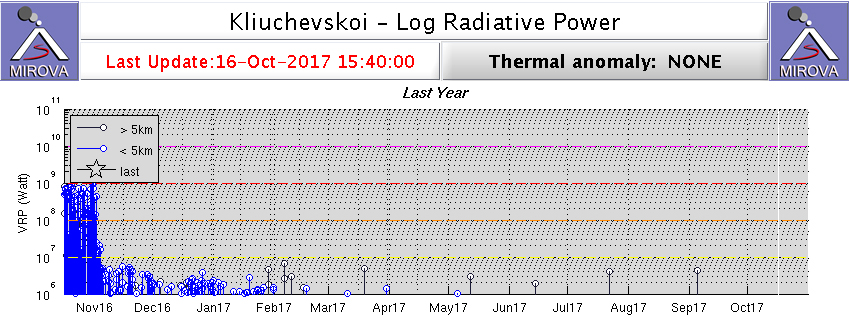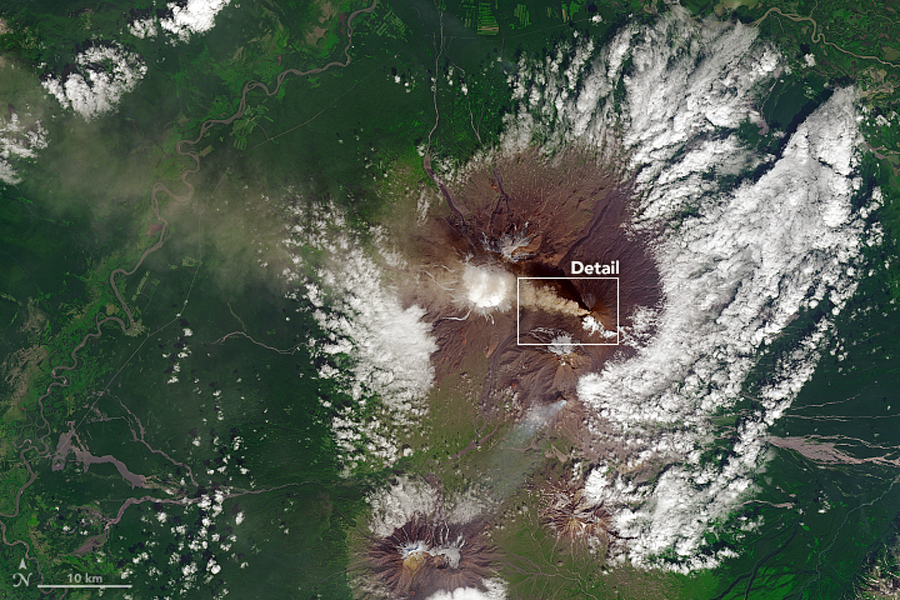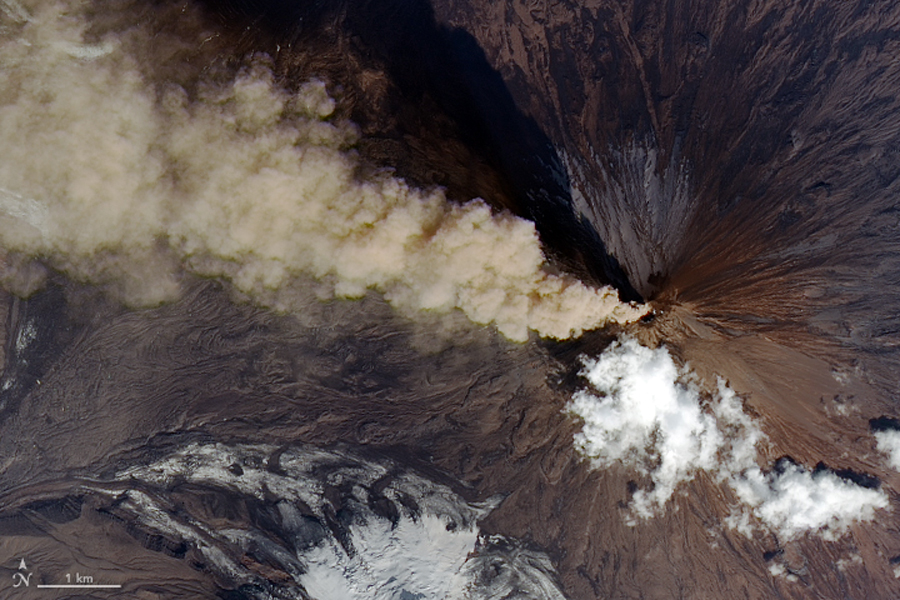Report on Klyuchevskoy (Russia) — November 2017
Bulletin of the Global Volcanism Network, vol. 42, no. 11 (November 2017)
Managing Editor: Edward Venzke.
Research and preparation by Robert Andrews.
Klyuchevskoy (Russia) Eruption appears to have subsided after March 2017; ash plumes persist into October
Please cite this report as:
Global Volcanism Program, 2017. Report on Klyuchevskoy (Russia) (Venzke, E., ed.). Bulletin of the Global Volcanism Network, 42:11. Smithsonian Institution. https://doi.org/10.5479/si.GVP.BGVN201711-300260
Klyuchevskoy
Russia
56.056°N, 160.642°E; summit elev. 4754 m
All times are local (unless otherwise noted)
The eruption of Klyuchevskoy that began in late August 2015 continued with fluctuating activity through March 2017 (BGVN 42:04) (figure 20). Although lava effusion ended in early November 2016, explosive activity was observed through March 2017 (BGVN 42:04). Similar eruptive activity continued through October 2017 as reported here, exhibiting moderate to strong ash explosions. The Kamchatkan Volcanic Eruption Response Team (KVERT) is responsible for monitoring this volcano, and is the primary source of information. Times are in UTC (local time is UTC + 12 hours).
 |
Figure 20. Ash plume rising from the summit crater of Klyuchevskoy on 30 March 2017. Courtesy of Yu. Demyanchuk (IVS FEB RAS, KVERT). |
KVERT reported that weak to moderate ash explosions and thermal anomalies occurred throughout March-October 2017 (table 17). The last time ash was reported during the period of this report was on 7 September 2017. The volcano is often obscured by clouds that prevent plumes from being detected in satellite imagery. However, excellent clear views from space were obtained on 10 June (figure 21) and 17 August 2017 (figures 22 and 23) that showed typical ash plumes. Ground-based observers also noted erupting ash plumes, some not identified in satellite imagery, including one on 8 October 2017 (figure 24).
Table 17. Summary of ash plumes and Aviation Color Codes at Klyuchevskoi from March through mid-October 2017. Data courtesy of KVERT.
| Dates | Ash plume altitude | Ash plume drift | Aviation Color Code (ACC) |
| 02 Mar 2017 | 8-9 km | 110 km NW and NE | Raised to Orange |
| 08 Mar 2017 | 5.5 km | 20 km NW | Orange |
| 16 Mar 2017 | -- | -- | Lowered to Yellow |
| 24 Mar 2017 | -- | -- | Lowered to Green |
| 28 Mar 2017 | 5-6 km | 108 km ENE | Raised to Yellow |
| 29 Mar 2017 | 7.5 km | 75 km SW | Raised to Orange |
| 01-04 Apr 2017 | 5-6 km | 400 km various directions | Lowered to Yellow |
| 21-28 Apr 2017 | -- | 125 km SW | Orange |
| 5-6, 10-11 May 2017 | -- | 270 km SE and NW | Orange |
| 17 May 2017 | 6 km | 180 km N and NE | Orange |
| 01-02 Jun 2017 | 6 km | 400 km SSE | Orange |
| 02-09 Jun 2017 | 5 km | 325 km NE, SE, and SW | Orange |
| 09-16 Jun 2017 | 6-7 km | 580 km SW and SE | Orange |
| 16-17, 22 Jun 2017 | 6-7 km | 300 km E and W | Orange |
| 24, 26 Jun 2017 | 5-6 km | 112 km S and SE | Orange |
| 01-03, 05-06 Jul 2017 | 5 km | 160 km SE, E, and SW | Orange |
| 08, 12-13 Jul 2017 | 5 km | 50 km SE | Orange |
| 19-20 Jul 2017 | -- | 300 km SW, SE, E, and NE | Orange |
| 22-27 Jul 2017 | -- | 120 km E and NE | Orange |
| 02-03 Aug 2017 | -- | 65 km SW and 250 km ESE | Orange |
| 11-12, 15-17 Aug 2017 | -- | 315 km E and NW | Orange |
| 19 Aug 2017 | 6 km | 140 km NW, 270 km SE, 90 km NE | Orange |
| 20 Aug 2017 | -- | 200 km NW | Orange |
| 21 Aug 2017 | -- | 480 km NW | Orange |
| 22 Aug 2017 | -- | 110 km NW, W, and SW | Orange |
| 23 Aug 2017 | -- | 220 km NW | Orange |
| 24-25, 30 Aug 2017 | 6 km | 550 km various directions | Lowered to Yellow |
| 07 Sep 2017 | 6 km | 50 km NE | Orange |
 |
Figure 24. Ash plume rising from the summit crater of Klyuchevskoy on 8 October 2017. Courtesy of I. Borisov (IVS FEB RAS). |
Thermal alerts in the MODVOLC system ended on 2 November 2016, corresponding to the end of lava effusion reported by KVERT (BGVN 42:04). The number of MIROVA thermal anomalies decreased significantly in early November 2016 as well (figure 25), then gradually declined further over the next few months.
 |
Figure 25. MODIS thermal anomalies identified in the MIROVA system, plotted as log radiative power for the year ending 24 October 2017. Courtesy of MIROVA. |
Geological Summary. Klyuchevskoy is the highest and most active volcano on the Kamchatka Peninsula. Since its origin about 6,000 years ago, this symmetrical, basaltic stratovolcano has produced frequent moderate-volume explosive and effusive eruptions without major periods of inactivity. It rises above a saddle NE of Kamen volcano and lies SE of the broad Ushkovsky massif. More than 100 flank eruptions have occurred during approximately the past 3,000 years, with most lateral craters and cones occurring along radial fissures between the unconfined NE-to-SE flanks of the conical volcano between 500 and 3,600 m elevation. Eruptions recorded since the late 17th century have resulted in frequent changes to the morphology of the 700-m-wide summit crater. These eruptions over the past 400 years have originated primarily from the summit crater, but have also included numerous major explosive and effusive eruptions from flank craters.
Information Contacts: Kamchatka Volcanic Eruptions Response Team (KVERT), Far Eastern Branch, Russian Academy of Sciences, 9 Piip Blvd., Petropavlovsk-Kamchatsky, 683006, Russia (URL: http://www.kscnet.ru/ivs/kvert/); Institute of Volcanology and Seismology, Far Eastern Branch, Russian Academy of Sciences (IVS FEB RAS), 9 Piip Blvd., Petropavlovsk-Kamchatsky 683006, Russia (URL: http://www.kscnet.ru/ivs/eng/); MIROVA (Middle InfraRed Observation of Volcanic Activity), a collaborative project between the Universities of Turin and Florence (Italy) supported by the Centre for Volcanic Risk of the Italian Civil Protection Department (URL: http://www.mirovaweb.it/); Hawai'i Institute of Geophysics and Planetology (HIGP) - MODVOLC Thermal Alerts System, School of Ocean and Earth Science and Technology (SOEST), Univ. of Hawai'i, 2525 Correa Road, Honolulu, HI 96822, USA (URL: http://modis.higp.hawaii.edu/); NASA Earth Observatory, EOS Project Science Office, NASA Goddard Space Flight Center, Goddard, Maryland, USA (URL: http://earthobservatory.nasa.gov/).




